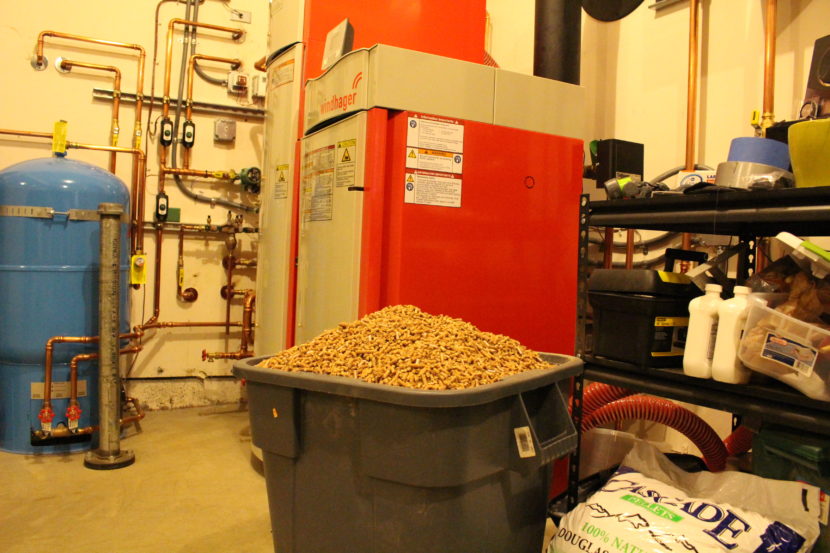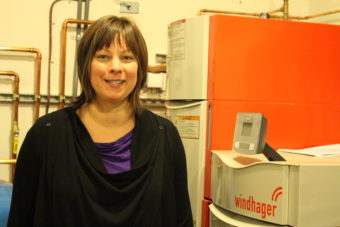
The Ketchikan airport has one. So does the Walter Sobeloff Building in downtown Juneau. Now, a fringe group of homeowners are installing wood pellet boilers to heat their homes. Not to be confused with wood burning stoves, these boilers have been marketed as a cheaper alternative to heating oil, at least in the long run. But is the framework there to make the technology go mainstream?
Christal Higdon and her family recently celebrated the installation of a new wood pellet boiler in their garage. When the moment came to hit the switch, after a year of anticipation, Higdon said they didn’t pop open champagne, but they did make brownies.
“[We] invited the electrician and the plummer and everyone over,” Higdon said with a laugh. She made a crock pot of chili to share with everyone as they fired up the boiler for the first time.
Higdon is one of about four homeowners in Juneau who have made the transition from electric resistance heat or oil to a wood pellet boiler.
It works like this: the pellets ignite and that heat is transferred through pipes of water around the home. The boilers can run about $12,000 just for the equipment itself. Not included in that price are the installation and upgrades needed to the home.
But Higdon said, for her family, it seemed worth the initial investment.
“It just felt right for us to move away from the dependence on oil wherever we could,” Higdon said. “And the time was right to replace our boiler, so we were looking at some kind of renewable energy we could use.”
Whether or not wood pellet boilers are a “renewable” form of energy is debated, especially when the pellets have to be shipped from someplace else. Still, Higdon said her reasons for wanting it were practical, as well as environmental. She learned about the system through word-of-mouth. And with any emerging technology, she said they’ve run into a few surprises with putting one in their house.
“Well, we had to find someone who could install it without maybe knowing how,” Higdon said.
And now there’s another hoop to jump through: Building a wood pellet shed. It’s not a necessity, but it would make it easier for Higdon’s family. They would only have to fill it up about once a year. The shed has special dimensions and a sloped floor which feeds the boiler.

“So the folks in town, several contractors had never built anything like that,” Higdon said.
“We were listening. She came at the right time,” Justin Fantasia said. He’s a faculty member at the University of Alaska Southeast and teaches construction technology. “We were trying to figure out what kind of project we wanted to do.”
Fantasia said — although it’s a unique arrangement — his class sometimes partners with people. Higdon is paying for the materials but Fantasia’s spring semester will be building the pellet shed. He says the main focus is to swing a hammer and to see a project through from start to finish. In a previous semester, university students built a tiny house.
“We don’t want to be trendy, but we want to pay attention to what people are excited about,” Fantasia said.
And for the time being, that seems like it could be wood pellet boilers. Fantasia said the university would consider teaching a class on the the installation — if there was interest.
“Construction technology changes super fast,” Fantasia said. “Seeing new products come on the market, new techniques, new concerns with changing cost of oil. Hopefully, going up for at least the state’s reason.”
Oil prices are going up but the overall price of heating fuel is cheaper than it’s been in the past. Higdon thinks her wood pellet boiler will eventually pencil out in the next four years.
In the meantime, as she waits for the shed, she’s keeping the golden pellets of Douglas Fir in a grey plastic bucket. Her family buys them in bulk at Home Depot — shipped from Oregon. There’s a business in Ketchikan that makes wood pellets but there’s not a bulk delivery system yet.
Higdon said, living in the Tongass, she would prefer to buy local.
“So if that’s available in the future, we’re hoping there’s enough demand that is created by people installing them, something like that could happen for Juneau,” Higdon said.
Sealaska, the regional Native corporation, outfitted its headquarters with a wood pellet boiler. About two years ago, it added another when it opened the Walter Sobeloff Building. In the past, the corporation has shown interest in developing the wood pellet market in Southeast by creating demand.
But as of now, the pellets it’s using come from Washington state and British Columbia.




